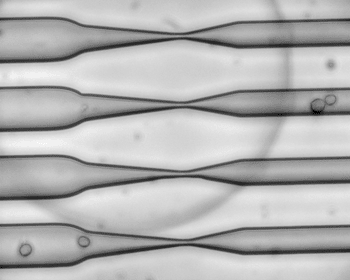Researchers Deform Cells to Deliver RNA, Proteins, and Nanoparticles for Many Applications
By LabMedica International staff writers
Posted on 06 Feb 2013
Researchers have found a safe and effective way to push large molecules through the cell membrane by jamming the cells through a narrow constriction that opens up very small, temporary holes in the membrane. Any large molecules drifting outside the cell—such as proteins, RNA, or nanoparticles—can slide through the membrane during this disruption.Posted on 06 Feb 2013
Living cells are enclosed by a membrane that closely controls what gets in and out of the cell. This barrier is necessary for cells to control their internal environment, but it makes it more difficult for scientists to deliver large molecules such as nanoparticles for imaging, or proteins that can reprogram them into pluripotent stem cells.

Image: As cells squeeze through a narrow channel, tiny holes open in their membranes, allowing large molecules such as RNA to pass through (Photo courtesy of Armon Sharei and Emily Jackson).
Using this technique, the Massachusetts Institute of Technology (MIT; Cambridge, MA, USA: www.mit.edu) researchers were able to deliver reprogramming proteins and create induced pluripotent stem cells with a success rate 10 to 100 times superior than any existing application. They also used it to deliver nanoparticles, including quantum dots and carbon nanotubes, which can be used to image cells and track what is occurring inside them.
“It’s very useful to be able to get large molecules into cells. We thought it might be interesting if you could have a relatively simple system that could deliver many different compounds,” said Dr. Klavs Jensen, a professor of chemical engineering, professor of materials science and engineering, and a senior author of a paper describing the new device in this week’s issue of the Proceedings of the National Academy of Sciences of the United States of America (PNAS).
Scientists had earlier developed several approaches to get large molecules into cells, but all of them have downsides. DNA or RNA can be parceled into viruses, which are proficient at entering cells, but that approach carries the risk that some of the viral DNA will be incorporated into the host cell. This application is commonly used in lab experiments but has not been approved by the US Food and Drug and Administration (FDA) for use in human patients.
Another way to transport large molecules into a cell is to tag them with a short protein that can penetrate the cell membrane and tug the larger payload along with it. Alternatively, DNA or proteins can be packaged into synthetic nanoparticles that can enter cells. However, these systems frequently need to be remodified depending on the type of cell and substance being delivered. Moreover, with some nanoparticles, a lot of the material ends up stuck in protective sacs called endosomes inside the cell, and there can be potential toxic side effects.
Electroporation, which involves jolting cells with electricity that opens up the cell membrane, is a more general approach but can be damaging to both cells and the material being delivered.
The new MIT system appears to work for many cell types—up to now, the researchers have successfully tested it with more than a dozen types, including both human and mouse cells. It also works in cells taken directly from human patients, which are typically much more difficult to engineer than human cell lines grown specifically for lab research.
The new device builds on earlier research by Jensen and Langer’s labs, in which they used microinjection to push large molecules into cells as they flowed through a microfluidic device. This was not as fast as the researchers hoped, but during these studies, they discovered that when a cell is squeezed through a narrow tube, small holes open in the cell membrane, allowing neighboring molecules to diffuse into the cell.
To take advantage of that, the researchers built rectangular microfluidic chips, about the size of a quarter, with 40 to 70 parallel channels. Cells are suspended in a solution with the material to be delivered and flowed through the channel at high speed—approximately one meter per second. Halfway through the channel, the cells pass through a constriction about 30%–80% smaller than the cells’ diameter. The cells do not sustain any permanent damage, and they maintain their normal functions after the treatment.
The scientists are now studying stem cell manipulation, which has potential for treating a wide range of diseases. They have already shown that they can convert human fibroblast cells into pluripotent stem cells, and now plan to start working on delivering the proteins needed to differentiate stem cells into specialized tissues.
Another promising application is delivering quantum dots—nanoparticles made of semiconducting metals that fluoresce. These dots hold promise for labeling individual proteins or other molecules inside cells, but scientists have had trouble getting them through the cell membrane without being trapped in endosomes.
In earlier work in November 2012, working with MIT graduate student Jungmin Lee and chemistry professor Dr. Moungi Bawendi, the researchers demonstrated that they could get quantum dots inside human cells grown in the laboratory, without the particles becoming confined in endosomes or clumping together. They are now working on getting the dots to tag specific proteins inside the cells.
The researchers are also exploring the possibility of using the new system for vaccination. In theory, scientists could take immune cells from a patient, run them through the microfluidic device and expose them to a viral protein, and then put them back in the patient. Once inside, the cells could provoke an immune response that would confer immunity against the target viral protein.
Related Links:
Massachusetts Institute of Technology














